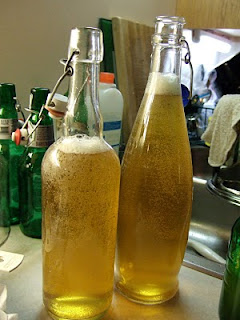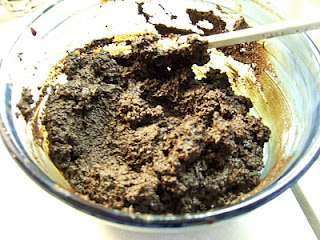The "mushroom", also called a SCOBY (or Symbiotic Colony of Bacteria and Yeasts), eats up the sugar and turns it into something healthy. How cool is that?! So basically, it's a drink that's good for you! And it's super easy to make at home. You can even make your own scoby!
How to make your own scoby:
Buy a 16 oz. bottle of kombucha from the grocery store. Pour it into another jar with a wider lid, like a wide-mouth quart-size jar. Put a breathable cover on the jar. I put a coffee filter on with a rubber band to hold it in place. Let sit on your counter until a layer begins to form on top. It will probably take about 7-10 days till it's ready. We didn't add anything, just let it sit till that scoby formed.
Okay, now that your science experiment is ready :-) you can move on to the next part.
How to make your own kombucha tea (the Merseth way):
There are a lot of different ways to make it out there, but I just follow the recipe from Nourishing Traditions Cookbook by Sally Fallon.
3 qts. filtered water
1 c. sugar (preferably organic)
4 tea bags (organic--I'll explain why this is especially important later)
1 scoby
1/2 c. starter culture-- ie, kombucha tea from previous batch (or the tea you used to make your mushroom... I usually use closer to 1 c., just because I want to make sure the tea stays acidic enough so it won't mold.)
1. Boil water.
2. Dissolve sugar in the water.
3. Add tea bags. (I buy loose-leaf tea, and measure it into a coffee filter, and tie it with a twisty tie. That's what you see in my picture. Also it's important to get good organic tea. Here's why, as well as additional info about K-tea's benefits and ways to make it properly. Basically, organic will ensure the viability of your tea... In the beginning, I used tea that wasn't organic and it made my mushroom mold... like fuzzy white stuff! Had to throw it away!) Wait until the tea is room temperature before moving on, otherwise your newly made scoby will be ruined.
4. Pour your brewed tea into a gallon jar. Carefully place your mushroom on top of the tea with the stringy things hanging down, then pour the starter culture gently on top. Cover with a breathable lid, like a dish towel or a coffee filter tied on.
5. Put on a shelf and wait a week. Check the taste by sticking a straw down in the middle of the liquid and drawing it out with your finger on one end and pour the liquid in your mouth. If it's effervescent, with a slight tangy apple juice with a touch of vinegar taste, it's done. Mine usually has to go for 9 days in this colder weather. In warmer weather, it will take less time. Also, if you prefer it less vinegary, brew for less time. Here's a picture of mine after 9 days. See the stringy things? That's part of the scoby.
6. Bottle the liquid, reserving enough for your next batch.
7. We leave our bottled kombucha on the counter for a second ferment for 2-5 days. Gives it more zip. You can also add different flavors to the second ferment. We've put in white grape juice concentrate before. We'll try more in the future. There's lots of websites out there with ideas. Mainly, we like it plain! Also, we use jars like you see in the photo. They're kind of hard to get, and a little spendy. We lucked out and found some for cheap in a store that was closing them out. They had fru fru pop in them. And my husband bought the green jars from a liquor store... imported German beer came in them, and it was cheaper to buy them that way (about $2 a bottle) rather than just buying the bottles themselves! Otherwise, you could use old glass juice bottles or something similar. I prefer glass to plastic. But that's for another post....

With each subsequent batch, new mushrooms will form on top. We have one saved with starter culture in the fridge in case one of our mushrooms goes bad. But you can give these mushrooms to friends, so they can make their own kombucha, too! It's almost like the Amish Friendship bread concept, but way better for you.
I started attempting to make this several years ago, but had trouble with mold. I didn't try again until this past fall 2009, when I finally realized after doing some research, about the importance of organic tea. Since then, we've been going gangbusters. LOVE the stuff. One note of caution. Don't drink too much at first, as it helps to detoxify the body. It's tempting to drink a lot, because it tastes so good. And since I don't drink soda pop, and kombucha is fizzy, it feels like I'm having a fun beverage. Here's a post about using kombucha tea while pregnant or nursing. I drink it, I just don't have more than a glass over the course of a day. Judah loves it--I think he likes the bubbles.
If you're interested in trying this out, I will have some extra scobys coming available soon, so let me know if you'd like one!






























